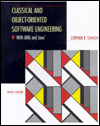
Classical and Object-Oriented Software Engineering W/ Uml and Java / Edition 4
by Stephen R. Schach, Stephen R. SchachISBN-10: 0072302267
ISBN-13: 9780072302264
Pub. Date: 01/01/1998
Publisher: McGraw-Hill Higher Education
Overview
This text provides an introduction to the process of software engineering. The Universal Modeling Language (UML) has become an industry standard and now permeates this first edition. In this text, it is used for object-oriented analysis and design as well as when diagrams depict objects and their interrelationships. Design patterns, frameworks and software architecture have also become a popular topic in the field of software engineering and are part of a chapter on reuse, portability, and inoperability. The inoperabilty material includes sections on such hot topics as OLE, COM, and CORBA (you'll want to mention that this material is covered).THE DIFFERENCE BETWEEN THE SCHACH C++ AND JAVA BOOKS. These two books are completely identical in topic coverage, organization, and pedagogy. Even the pagingation of the two books is the same. While there is minimal computer code in either book, the difference is that where there is code, it is in C++ in one book and Java in the other. It is important to note that software engineering is independent of any specific programming language and your software engineering professors will likely emphasize this with you. But a specific language needs to be used to give examples and implement case studies -- these are done in C++ in one version and Java in the other.
Product Details
- ISBN-13:
- 9780072302264
- Publisher:
- McGraw-Hill Higher Education
- Publication date:
- 01/01/1998
- Edition description:
- Older Edition
- Pages:
- 616
- Product dimensions:
- 7.40(w) x 9.21(h) x 1.42(d)
Table of Contents
Part 1: Introduction to the Software Process1 Scope of Software Engineering
2 The Software Process
3 Software Life-Cycle Models
4 Teams and the Tools of Their Trade
5 Testing
6 Introduction to Objects
7 Reusability, Portability, and Interoperability
8 Planning and Estimating
Part 2: The Phases of the Software Life Cycle
9 Requirements Phase
10 Specification Phase
11 Object-Oriented Analysis Phase
12 Design Phase
13 Implementation Phase
14 Implementation and Integration Phase
15 Maintenance Phase
Appendixes
Customer Reviews
Average Review: